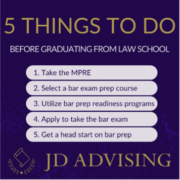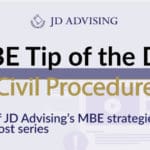Struggling With Bar Exam Essay Timing? 5 Great Tips to Improve Efficiency!
 Struggling With Bar Exam Essay Timing?
Struggling With Bar Exam Essay Timing?
5 Great Tips to Improve Efficiency!
One of the most difficult parts of the bar is the timing factor. Many of the essay questions themselves are rather straightforward – but when you include a time limit, the pressure increases. Students find themselves rushing so that they get through everything before time runs out. Unfortunately, this can lead to valuable points being left on the table. If you find yourself struggling to finish during your practice rounds, now is a good time to be looking for some great bar exam essay timing tips. And we can help you there!
Struggling With Bar Exam Essay Timing? 5 Great Tips to Improve Efficiency!
Before we present our 5 great bar exam essay timing tips, here’s a good overall strategy: work on improving your efficiency, not necessarily your speed. If you try to type faster, or read faster, you run into a whole new set of problems. It is a lot easier to make silly errors when you rush. While small spelling and grammar mistakes are forgiven, accidentally leaving out certain words because you’re trying to go fast can be crushing. There’s a big different between: “X will succeed on his claim” and “X will not succeed on his claim.” Leaving out that tiny word while rushing just changed your entire conclusion.
What is more important for improving your bar exam essay timing is being efficient in your answers. Learn the difference between what is necessary to include, and what might be correct but is just wasting your time. Becoming more efficient while you write by leaving out unnecessary statements will save you more time than just trying to type faster.
Here are our 5 great bar exam essay timing tips:
1. Read the question carefully – and start with the call!
The first thing you should always do is read the call of the question to determine the subject and what you need to be looking for in the pattern. Sometimes that will also require reading the immediately preceding paragraph as well. Reading the call first can allow you to narrow down what information will actually be relevant to answering the question.
If you just dive right into the fact pattern, you don’t really know what to identify as most important. Your brain might see a fact and start running through an analysis that ends up having nothing to do with what the question asks. You get to the end of the pattern thinking you have some things to say but then realize you completely missed the topic at issue and have to start all over.
Don’t rush through the fact pattern either. Take your time so that you don’t misunderstand anything that is presented. Accidentally skipping a sentence during a speed read could have devastating consequences in your analysis.
2. Answer specifically what the question asks.
Many questions will number the different issues they want to you to talk about. Structuring your essay in the way the examiner presents the question will help keep you focused. Don’t offer up an analysis on an issue that isn’t asked about. If the question asks you to present an argument for multiple parties, make sure you do that! Answer all parts of the question, making it clear to the grader that you are doing so, and then move on!
If the question only asks you to discuss whether person Y breached their duty of care, don’t present an analysis of why they were or were not the proximate cause of the harm. Stick to exactly what the call of the question wants you to answer!
3. Don’t offer long introductions.
It can be tempting to give a long introduction on the background of the subject at hand. While it won’t necessarily cost you points, it will cost you a lot of time. When the question involves one main issue, present what is necessary for the rule statement about that issue and then move on to your analysis. If the question asks “Can person X sue person Y for non-economic damages relating to their injuries in a car accident?” you don’t need to provide the history of the no-fault act and how much of one’s medical costs and lost wages it covers. Might it impress the grader? Sure! Could it take up valuable time you could be spending presenting a solid analysis? Absolutely.
When the question involves multiple issues, it is probably more efficient for you to do multiple IRACs instead of one gigantic rule introduction at the beginning. Then you’ll have to spend extra time constantly looking back to what you wrote at the top, making sure everything is consistent. Present the rule, analyze, conclude, and move on to the next issue or sub-question.
And if you have time at the end and want to include some of that introduction, go ahead and do it. However, if you find you are reaching the end of the time limit, then leave it out!
4. Keep practicing!
Too many times students will write a few essays, see that they are going over the time limit their state proivdes, and immediately decide to start writing shorter rule statements or analysis. When you purposely write less, you are inevitably leaving out essential information. Before making hasty decisions about trying to write less, practice more! Your timing will improve, but it takes practice to do that! Identify whether you are including any irrelevant information and cut that out, but don’t condense the important parts of your essays until you have given yourself a chance at improving. It is perfectly normal to have your essays take longer than 20 minutes at the beginning. The worst thing you can do is immediately overreact. You will get quicker over time!
This probably goes without saying, but the best bar exam essay timing tip is to practice, practice, practice! As was mentioned above, your timing will improve! You can’t expect yourself to having the timing down perfectly at the beginning of your bar prep. You need to keep developing your skills. Also important is to do multiple practice essays for each topic as you need exposure as to how the subjects are presented. The essays for some subjects tend to be longer than others. If you can learn these trends, you can begin to understand where on the exam you can pick up some time and where you might need a little extra. You will never improve your times if you don’t practice!
5. Learn the highly tested areas of law.
Not all topics are tested equally on the essay exam. Most examiners do not reinvent the wheel every time they write an exam question. On the contrary, some topics come up over. And over. And over again.
And students that are aware of these highly tested topics — and who study them — are not only rewarded with high scores, but they also find that they can type out rule statements faster rather than having to take valuable time trying to think back to their lengthy outlines!
One way to figure out the highly tested areas of law is, of course, to practice! You could even make your own bullet pointed list of the topics you come across to look for trends.
If you are in a Uniform Bar Exam or Multistate Essay Exam state, in this post, we tell you the exact highly-tested MEE topics for each subject! (You can also purchase our MEE one-sheets if you want even more detailed information on the highly tested MEE topics for each subject!) If you are in Michigan, check out our How to Pass the Michigan Bar Exam book which has “one-sheets” for each of the 24 Michigan subjects!
Learning the highly tested rules will give you confidence and speed!
Laura Sigler, a JD Advising bar exam essay grader, who graduated cum laude from Wayne State University Law School wrote this post.
Looking to Pass the Bar Exam?
Free Resources:
- 🌟Bar Exam Free Resource Center: Access our most popular free guides, webinars, and resources to set you on the path to success.
- Free Bar Exam Guides: Expert advice on the MBE, the MEE, passing strategies, and overcoming failure.
- Free Webinars: Get insight from top bar exam experts to ace your preparation.
Paid Resources:
- 🏆One-Sheets: Our most popular product! Master the Bar Exam with these five-star rated essentials.
- Bar Exam Outlines: Our comprehensive and condensed bar exam outlines present key information in an organized, easy-to-digest layout.
- Exclusive Mastery Classes: Dive deep into highly tested areas of the MBE, MEE, MPT, and CA bar exams in these live, one-time events.
- Specialized Private Tutoring: With years of experience under our belt, our experts provide personalized guidance to ensure you excel.
- Bar Exam Courses: On Demand and Premium options tailored to your needs.
- Bar Exam Crash Course + Mini Outlines: A great review of the topics you need to know!
🔥 NEW! Check out our Repeat Taker Bar Exam Course and our new premier Guarantee Pass Program!




